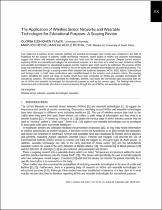 ResearchSpace
ResearchSpace
The application of wireless sensor networks and wearable technologies for educational purposes: A scoping review
JavaScript is disabled for your browser. Some features of this site may not work without it.
- ResearchSpace
- →
- Research Publications/Outputs
- →
- Conference Publications
- →
- View Item
| dc.contributor.author |
Iyawa, GE

|
|
| dc.contributor.author |
Herselman, Martha E

|
|
| dc.contributor.author |
Botha, Adèle

|
|
| dc.date.accessioned | 2018-01-31T06:51:08Z | |
| dc.date.available | 2018-01-31T06:51:08Z | |
| dc.date.issued | 2017-11 | |
| dc.identifier.citation | Iyawa, G.E., Herselman, M.E. and Botha, A. 2017. The application of wireless sensor networks and wearable technologies for educational purposes: A scoping review. Second International Conference on Advanced Wireless Information, Data, and Communication Technologies (AWICT 2017), 13-14 November 2017, CentraleSupélec, Université Paris, France | en_US |
| dc.identifier.isbn | 978-1-4503-5310-6 | |
| dc.identifier.uri | http://hdl.handle.net/10204/10004 | |
| dc.description | This is the accepted version of the paper. For access to the published version, kindly consult the publisher's webpage. | en_US |
| dc.description.abstract | Past researches in wireless sensor networks (WSNs) and wearable technologies have mostly been conducted in the field of healthcare for the purpose of patients’ health monitoring. However, recent studies in WSNs and wearable technologies suggest that WSNs and wearable technologies have also been used for educational purposes. Despite current research exploring WSNs and wearable technologies for educational purposes, it is less clear as to what has been studied on WSNs and wearable technologies for educational purposes and the research gaps which need to be addressed. The purpose of this study was therefore to conduct a scoping review on the use of WSN and wearable technologies for educational purposes. The search was conducted through a scoping review which adopted four academic databases: ACM, IEEE Xplore, ScienceDirect and Springer Link. In total, seven publications were identified based on the inclusion and exclusion criteria. The scoping review identified the extent and range of studies which have been conducted on WSNs and wearable technologies for educational purposes. The findings identified the challenges, benefits, cost issues and technology types associated with the use of WSNs and wearable technologies for educational purposes as well as the research gaps. The findings will inform researchers and professionals who desire to improve learning through the use of WSNs and wearable technologies. | en_US |
| dc.language.iso | en | en_US |
| dc.relation.ispartofseries | Worklist;19633 | |
| dc.subject | Wireless sensor networks | en_US |
| dc.subject | Wearable technologies | en_US |
| dc.title | The application of wireless sensor networks and wearable technologies for educational purposes: A scoping review | en_US |
| dc.type | Conference Presentation | en_US |
| dc.identifier.apacitation | Iyawa, G., Herselman, M. E., & Botha, A. (2017). The application of wireless sensor networks and wearable technologies for educational purposes: A scoping review. http://hdl.handle.net/10204/10004 | en_ZA |
| dc.identifier.chicagocitation | Iyawa, GE, Martha E Herselman, and Adèle Botha. "The application of wireless sensor networks and wearable technologies for educational purposes: A scoping review." (2017): http://hdl.handle.net/10204/10004 | en_ZA |
| dc.identifier.vancouvercitation | Iyawa G, Herselman ME, Botha A, The application of wireless sensor networks and wearable technologies for educational purposes: A scoping review; 2017. http://hdl.handle.net/10204/10004 . | en_ZA |
| dc.identifier.ris | TY - Conference Presentation AU - Iyawa, GE AU - Herselman, Martha E AU - Botha, Adèle AB - Past researches in wireless sensor networks (WSNs) and wearable technologies have mostly been conducted in the field of healthcare for the purpose of patients’ health monitoring. However, recent studies in WSNs and wearable technologies suggest that WSNs and wearable technologies have also been used for educational purposes. Despite current research exploring WSNs and wearable technologies for educational purposes, it is less clear as to what has been studied on WSNs and wearable technologies for educational purposes and the research gaps which need to be addressed. The purpose of this study was therefore to conduct a scoping review on the use of WSN and wearable technologies for educational purposes. The search was conducted through a scoping review which adopted four academic databases: ACM, IEEE Xplore, ScienceDirect and Springer Link. In total, seven publications were identified based on the inclusion and exclusion criteria. The scoping review identified the extent and range of studies which have been conducted on WSNs and wearable technologies for educational purposes. The findings identified the challenges, benefits, cost issues and technology types associated with the use of WSNs and wearable technologies for educational purposes as well as the research gaps. The findings will inform researchers and professionals who desire to improve learning through the use of WSNs and wearable technologies. DA - 2017-11 DB - ResearchSpace DP - CSIR KW - Wireless sensor networks KW - Wearable technologies LK - https://researchspace.csir.co.za PY - 2017 SM - 978-1-4503-5310-6 T1 - The application of wireless sensor networks and wearable technologies for educational purposes: A scoping review TI - The application of wireless sensor networks and wearable technologies for educational purposes: A scoping review UR - http://hdl.handle.net/10204/10004 ER - | en_ZA |





